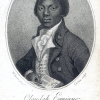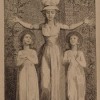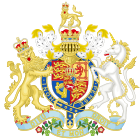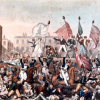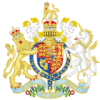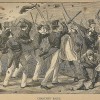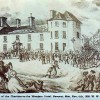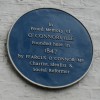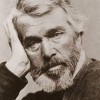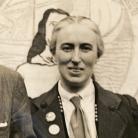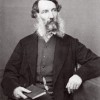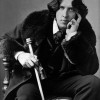Timeline: Race, Gender, Class, Sex
Created by Dino Franco Felluga on Tue, 08/24/2021 - 13:16
Part of Group:
 This timeline is part of ENGL 202's build assignment. Research a topic that teaches us something about race, class, gender, or sexuality and then contribute what you have learned to our shared class resource. As the assignment states, "Add one timeline element, one map element and one gallery image about race, class, gender, or sex to our collective resources in COVE Editions. Provide images, sources and sufficient detail to explain the historical or cultural element that you are presenting. Interlink the three objects." A few timeline elements have already been added (borrowing from BRANCH).
This timeline is part of ENGL 202's build assignment. Research a topic that teaches us something about race, class, gender, or sexuality and then contribute what you have learned to our shared class resource. As the assignment states, "Add one timeline element, one map element and one gallery image about race, class, gender, or sex to our collective resources in COVE Editions. Provide images, sources and sufficient detail to explain the historical or cultural element that you are presenting. Interlink the three objects." A few timeline elements have already been added (borrowing from BRANCH).
Timeline
Chronological table
| Date | Event | Created by | Associated Places | |
|---|---|---|---|---|
| 9 Apr 1787 |
First settlers depart for Sierra Leone
Articles |
Dave Rettenmaier | ||
| Jan 1789 |
Interesting Narrative of the Life of Olaudah Equiano
Articles |
Dave Rettenmaier | ||
| 1 Jan 1792 |
Vindication of the Rights of Woman
ArticlesAnne K. Mellor, "On the Publication of A Vindication of the Rights of Woman" Related Articles |
Dave Rettenmaier | ||
| 10 Sep 1797 |
Death of Wollstonecraft
ArticlesAnne K. Mellor, "On the Publication of A Vindication of the Rights of Woman" |
Dave Rettenmaier | ||
| Jan 1798 |
Memoirs of the Author of a VindicationOn January 1798, publication of William Godwin’s Memoirs of the Author of A Vindication of the Rights of Woman. The publication of this first biography of Wollstonecraft causes a scandal and Godwin publishes a second “corrected” edition of the Memoirs in the summer of the same year. ArticlesRelated ArticlesAnne K. Mellor, "On the Publication of A Vindication of the Rights of Woman" |
Dave Rettenmaier | ||
| 22 Jun 1802 |
Criminal Jurisdiction Act passed
Articles |
Dave Rettenmaier | ||
| 18 Jan 1819 |
St. Peter's Field meetingOn 18 January 1819, Henry Hunt presided at a meeting of 8,000 operatives on St. Peter’s Field in Manchester. Articles |
Dave Rettenmaier | ||
| 15 Feb 1819 |
Sandy Brow FightOn 15 February 1819, William Fitton presided at a public meeting at Sandy Brow in Stockport (the so-called “Sandy Brow Fight”), number present not known, where a scuffle involving stones and brickbats occurred over an attempt by the military to seize the Cap of Liberty; the Riot Act was read three times. Articles |
Dave Rettenmaier | ||
| 14 Jun 1819 |
Ashton-under-Lyne meetingOn 14 June 1819, Joseph Harrison presided at a meeting of 12,000–15,000 at Ashton-under-Lyne; this was typical of a spate of June meetings at Oldham, Bolton, Royton, Bury, Heywood, Stockport, Failsworth, Gee Cross, Lees, Middleton, Rochdale, Todmorden, Barnsley, Holmfirth, Leeds, and other towns that were unrepresented in Parliament. Articles |
Dave Rettenmaier | ||
| 16 Jun 1819 |
Glasgow meeting of weaversOn 16 June 1819, 40,000 weavers met at Glasgow to petition the Prince Regent for passage money to Canada for the unemployed. Articles |
Dave Rettenmaier | ||
| 28 Jun 1819 |
Stockport meetingOn 28 June 1819, at the great Stockport meeting, the largest of its kind besides Peterloo, upwards of 20,000 assembled to hear Sir Charles Wolseley speak on Parliamentary reform. Articles |
Dave Rettenmaier | ||
| 16 Aug 1819 |
Peterloo massacre
Related ArticlesJames Chandler, “On Peterloo, 16 August 1819″ Sean Grass, “On the Death of the Duke of Wellington, 14 September 1852″ |
Dave Rettenmaier | ||
| 2 Sep 1819 |
Westminster meetingOn 2 September 1819, 15,000–50,000 people assembled in Westminster and were addressed by Francis Burdett and Major Cartwright. The Examiner for that date confirmed 2 September as the correct date. This followed a smaller protest meeting at Smithfield the week before. Articles |
Dave Rettenmaier | ||
| 1 Nov 1819 |
Simultaneous radical meetingsOn 1 November 1819, simultaneous meetings were held, by prior agreement, at Newcastle, Carlisle, Leeds Halifax, Manchester, Bolton, Nottingham, Leicester, Coventry, and elsewhere in England and Scotland. Articles |
Dave Rettenmaier | ||
| 15 Nov 1819 |
Simultaneous Scottish radical meetingsOn 15 November 1819, simultaneous radical meetings occurred at Paisley, Glasgow, and other locations across Scotland. Articles |
Dave Rettenmaier | ||
| 30 Dec 1819 |
Gag Acts
Articles |
Dave Rettenmaier | ||
| 29 Aug 1833 |
Slavery Abolition Act
Articles |
Dave Rettenmaier | ||
| 14 Jun 1839 |
First Chartist Petition
ArticlesChris R. Vanden Bossche, "On Chartism" Related ArticlesJo Briggs, “1848 and 1851: A Reconsideration of the Historical Narrative” |
Dave Rettenmaier | ||
| Nov 1839 |
Newport Uprising
ArticlesChris R. Vanden Bossche, "On Chartism" Related ArticlesJo Briggs, “1848 and 1851: A Reconsideration of the Historical Narrative” |
Dave Rettenmaier | ||
| 2 May 1842 |
Second Chartist Petition
ArticlesChris R. Vanden Bossche, "On Chartism" Related ArticlesJo Briggs, “1848 and 1851: A Reconsideration of the Historical Narrative” |
Dave Rettenmaier | ||
| 8 Aug 1842 |
Manchester strike
ArticlesChris R. Vanden Bossche, "On Chartism" Related ArticlesJo Briggs, “1848 and 1851: A Reconsideration of the Historical Narrative” |
Dave Rettenmaier | ||
| Apr 1846 |
Formation of the Chartist Land Company
Articles |
Dave Rettenmaier | ||
| 17 Aug 1846 |
Opening festival for O’Connorville
Articles |
Dave Rettenmaier | ||
| 10 Apr 1848 |
Chartist Rally, Kennington
Led by Feargus O’Connor, an estimated 25,000 Chartists meet on Kennington Common planning to march to Westminster to deliver a monster petition in favor of the six points of the People’s Charter. Police block bridges over the Thames containing the marchers south of the river, and the demonstration is broken up with some arrests and violence. However, the large scale revolt widely predicted and feared fails to materialize. ArticlesJo Briggs, “1848 and 1851: A Reconsideration of the Historical Narrative” |
Dave Rettenmaier | ||
| 1 Jul 1848 |
Trial of Chartist leaders
The summer of 1848 witnesses violence as Chartist leaders are arrested and secret plots against the government are infiltrated. By the end of August, after the arrest of several hundred Chartists and Irish Confederates, the movement for violent uprising in England is broken. ArticlesJo Briggs, “1848 and 1851: A Reconsideration of the Historical Narrative” |
Dave Rettenmaier | ||
| Dec 1849 |
Carlyle's "Negro Question"
Articles |
Dave Rettenmaier | ||
| 29 Spring 1851 |
“Ain’t I a Woman?” Speech at the Ohio Women’s Rights ConventionOn May 29th, 1851, Sojourner Truth, an abolitionist and women’s rights activist, delivered her famous “Ain’t I A Woman?” speech at the Ohio Women’s Rights Convention in Akron, Ohio. This convention was one of many that brought together a variety of activists who later helped to win the passage of the 19th amendment. The activists at this convention were inspired by the Declaration of Rights and Sentiments created at the Seneca Falls convention of 1848. This Declaration described women’s grievances and demands for their rights to equality as U.S. citizens, and the conversation continued in Akron, Ohio. The Ohio Women’s Rights Convention is most well known for being the venue in which Sojourner’s “Ain’t I A Woman?” speech took place. Though there are different versions of her speech, one published a month after the speech was given, by Reverend Marius Robinson, and one twelve years after the speech was given, published by Frances Gage, both touch on the intersectionality that exists between feminism and anti-racism. In Gage’s inaccurate transcript, Truth says “I think that betwixt the Negroes of the South and the women at the North all talking about rights, these white men going to be in a fix pretty soon.” In Robinson’s historically correct transcript, Truth says “But man is in a tight place, the poor slave is on him, woman is coming on him, and he is surely between-a hawk and a buzzard.” Both versions of Sojourner Truth’s speech present the idea of white feminists and black feminists working together to simultaneously defeat the patriarchy and abolish slavery, rather than to let white feminism drown out black women’s voices. Podell, Leslie. “Compare the Two Speeches.” The Sojourner Truth Project, www.thesojournertruthproject.com/compare-the-speeches/. History.com Editors. “Seneca Falls Convention.” History.com, A&E Television Networks, 10 Nov. 2017, www.history.com/topics/womens-rights/seneca-falls-convention. “Ain't I A Woman?” Learning for Justice, www.learningforjustice.org/classroom-resources/texts/aint-i-a-woman. |
Arden Woodall | ||
| Aug 1851 |
Chancery Court orders closing of O’Connorville
Articles |
Dave Rettenmaier | ||
| 10 May 1857 to 20 Jun 1858 |
Indian Uprising
ArticlesPriti Joshi, “1857; or, Can the Indian ‘Mutiny’ Be Fixed?” Related ArticlesJulie Codell, “On the Delhi Coronation Durbars, 1877, 1903, 1911″ |
Dave Rettenmaier | ||
| Jun 1858 |
Sale of the final piece of Chartist propertyJune 1858 saw the sale of the final piece of Chartist property, definitively bringing to an end the efforts of the Chartist Cooperative Land Company. The Chartist Land Company was a large-scale, explicitly political version of freehold societies. Conceived by the Chartist leader Feargus O’Connor in 1842, the Company, like freehold societies, purchased large tracts of land through subscriptions and then sold smaller parcels to subscribers. It attempted to re-create village life by building cottages, hospitals, and schools, and setting aside one hundred acres for common use. Articles |
Dave Rettenmaier | ||
| 23 Nov 1861 |
Birth of Clemence Annie HousmanClemence Annie Housman was born in Bromsgrove, England, on November 23, 1861. Saint Clement’s Day in the liturgical calendar marks the traditional beginning of winter. Housman was the third child and oldest girl in a family of seven children, the eldest of whom was A.E. Housman (1859-1936), the poet. Clemence was very close to the second youngest of her siblings, Laurence Housman (1865-1959), with whom she lived and worked her entire life. In addition to writing novels, Houseman was a wood engraver and an activist in the feminist movement for female suffrage. (Oakley, Inseparable Siblings)
|
Lorraine Janzen Kooistra | ||
| 2 Oct 1865 |
George William Gordon executedGordon, a Jamaican former slave and elected member of the Jamaica House of Assembly, is executed by hanging after a court martial condemns him to death for his alleged role in encouraging the Morant Bay rebellion. Articles |
Dave Rettenmaier | ||
| 11 Oct 1865 |
Morant Bay Rebellion
Articles |
Dave Rettenmaier | ||
| Dec 1865 |
“Jamaica Committee”
Articles |
Dave Rettenmaier | ||
| 2 Jul 1866 |
Hyde Park demonstrationHyde Park Demonstration of the Major Reform League on 23 July 1866. After the British government banned a meeting organized to press for voting rights, 200,000 people entered the Park and clashed with police and soldiers. Related ArticlesPeter Melville Logan, “On Culture: Matthew Arnold’s Culture and Anarchy, 1869″ |
Dave Rettenmaier | ||
| 11 Feb 1867 |
Trafalgar Square demonstrationMajor Reform League march and demonstration in Trafalgar Square, London on 11 February 1867. Related Articles |
Dave Rettenmaier | ||
| 27 Mar 1867 |
Edward John Eyre indictment hearing
Articles |
Dave Rettenmaier | ||
| 11 Apr 1867 |
Nelson and Brand charges dismissedA Middlesex grand jury at London’s Old Bailey criminal court dismissed charges brought by the Jamaica Committee against Colonel Abercrombie Nelson and Lieutenant Herbert Brand for the murder (via illegal court martial) of George William Gordon at Morant Bay, Jamaica in October 1865. The trial was a result of the Morant Bay Rebellion of 11 October 1865. Articles |
Dave Rettenmaier | ||
| 15 Aug 1867 |
Second Reform Act
ArticlesJanice Carlisle, "On the Second Reform Act, 1867" Related ArticlesCarolyn Vellenga Berman, “On the Reform Act of 1832″ Elaine Hadley, “On Opinion Politics and the Ballot Act of 1872″ |
Dave Rettenmaier | ||
| Jun 1868 |
Edward John Eyre acquitted
Articles |
Dave Rettenmaier | ||
| Jun 1870 |
Civil suit against Edward John Eyre nullified
Articles |
Dave Rettenmaier | ||
| 14 Aug 1885 |
Criminal Law Amendment Act
Related ArticlesMary Jean Corbett, “On Crawford v. Crawford and Dilke, 1886″ Andrew Elfenbein, “On the Trials of Oscar Wilde: Myths and Realities” |
Dave Rettenmaier | ||
| Apr 1895 to May 1895 |
Trials of Oscar Wilde
ArticlesAndrew Elfenbein, “On the Trials of Oscar Wilde: Myths and Realities” |
Dave Rettenmaier | ||
| 14 Spring 1897 to 1933 |
The Rise of Gay RightsThe first gay-rights organization that was founded and recorded in history was in Berlin, called the Scientific-Humanitarian Commitee or Wissenschaftlich-humanitäres Komitee; WhK in German. It was founded in 1897, on the 14th or 15th of May, which was four days before Oscar Wilde's release from prison, and shut down in 1933. The founder of the Scientific-Humanitarian Commitee was Magnus Hirschfeld, who opened an Institute for Sexual Science in 1919, which was anticipated by decades of other scientific centres that specialized in sex research. Another notable thing that he did was sponsor the World League of Sexual Reform in 1928. Original members of the WhK included Hirschfeld, publisher Max Spohr, lawyer Eduard Oberg and writer Franz Joseph von Bülow, Adolf Brand, Benedict Friedländer, Hermann von Teschenberg and Kurt Hiller also joined the organization. There was a brief split in 1907, and In 1929, Hiller took over as chairman of the group from Hirschfeld. At its peak, the Scientific-Humanitarian Commitee had branches in approximately 25 cities in Germany, Austria, and the Netherlands. The Scientific-Humanitarian Commitee inspired many gay-rights organizations that came after it. Henry Gerber, who was a German Immigrant that served in the U.S. Army during World War I, was inspired to create his own gay-rights organization in 1924 called the Society for Human Rights, and it is considered the first documented gay rights organization in the United States. It was a very small group, but they did publish a few issues of a newsletter called “Friendship and Freedom,” and that is known as the country’s first gay-interest newsletter. The Society for Human Rights was very short lived and disbanded in 1925 after police raids. After that there were many organizations that came to be such as the Mattachine Society, founded in L.A. in 1950 and is regarded as the first viable U.S. gay rights organization. Also the Daughters of Bilitis, founded in San Francisco in 1955 as the first U.S. lesbian organization. Encarnación, Omar G. “Gay Rights: Why Democracy Matters.” Journal of Democracy, Johns Hopkins University Press, 14 July 2014, https://muse.jhu.edu/article/549501/summary?casa_token=pFORmtmjcrgAAAAA%3AX9OojUdlp9XRFptTfbGHlk6Zkx4-3OqX7EkwTXcttL2s1Emd-OO0nmFSZ0yiFajqUTeQdE33. History.com Editors. “Gay Rights.” History.com, A&E Television Networks, 28 June 2017, https://www.history.com/topics/gay-rights/history-of-gay-rights. “Gay Rights Movement.” Encyclopædia Britannica, Encyclopædia Britannica, Inc., https://www.britannica.com/topic/gay-rights-movement. “Scientific-Humanitarian Committee Information.” WISSENSCHAFTLICH-HUMANITäRES KOMITEE - Encyclopedia Information, https://webot.org/info/en/?search=Wissenschaftlich-humanit%C3%A4res_Komitee. |
Jessica Moya | ||
| 18 Jul 1899 to 2 Aug 1899 |
The Newsboys Strike of 1899
Hicks, Greg. “University of North Carolina at Asheville. an Uncivil War: The New York City Newsboys Strike of PDF Free Download.” University of North Carolina at Asheville. An Uncivil War: The New York City Newsboys Strike of PDF Free Download, https://docplayer.net/34730531-University-of-north-carolina-at-asheville.... Newsboys' Strike of 1899 Explained, Everything.Explained.Today , https://everything.explained.today/Newsboys%27_strike_of_1899/. |
Mackenzie Fischer | ||
| 11 Oct 1899 to 31 May 1902 |
Second Boer War
ArticlesJo Briggs, “The Second Boer War, 1899-1902: Anti-Imperialism and European Visual Culture” |
Dave Rettenmaier | ||
| 17 May 1900 |
Siege of Mafeking lifted
ArticlesJo Briggs, “The Second Boer War, 1899-1902: Anti-Imperialism and European Visual Culture” |
Dave Rettenmaier | ||
| 30 Nov 1900 |
Death of Wilde
ArticlesEllen Crowell, “Oscar Wilde’s Tomb: Silence and the Aesthetics of Queer Memorial” Related ArticlesAndrew Elfenbein, “On the Trials of Oscar Wilde: Myths and Realities” |
Dave Rettenmaier | ||
| Jun 1901 |
Hobhouse report on Second Boer War
ArticlesJo Briggs, “The Second Boer War, 1899-1902: Anti-Imperialism and European Visual Culture” |
Dave Rettenmaier | ||
| 17 Jun 1911 |
Women's Suffrage Procession at Coronation of George V The "From Prison to Citizenship" banner at the Women's Coronation Procession, London, 1911. Photo by the Museum of London/Heritage Images/Getty Images. In this famous suffrage procession marking the Coronation of George V, the banner designed by Laurence and created by Clemence in 1908 for the Kensington Women’s Social and Political Union made one of its numerous appearances in public parades. The striking banner, “From Prison to Citizenship,” features the suffragist colours, depicting a white figure on a purple background, decorated with green vines. The design was so popular it was also incorporated into a postcard for wider distribution. Clemence personally enacted this slogan later in 1911, when she spent a week in Holloway Prison for refusing to pay property taxes until she was granted full citizenship. Her act of civil disobedience did not grant her full citizenship, but it did add strength to the movement. Some women got the vote in 1918, but it took until 1928 for universal female suffrage to be achieved in the United Kingdom (Liddington, Vanishing). |
Lorraine Janzen Kooistra |


